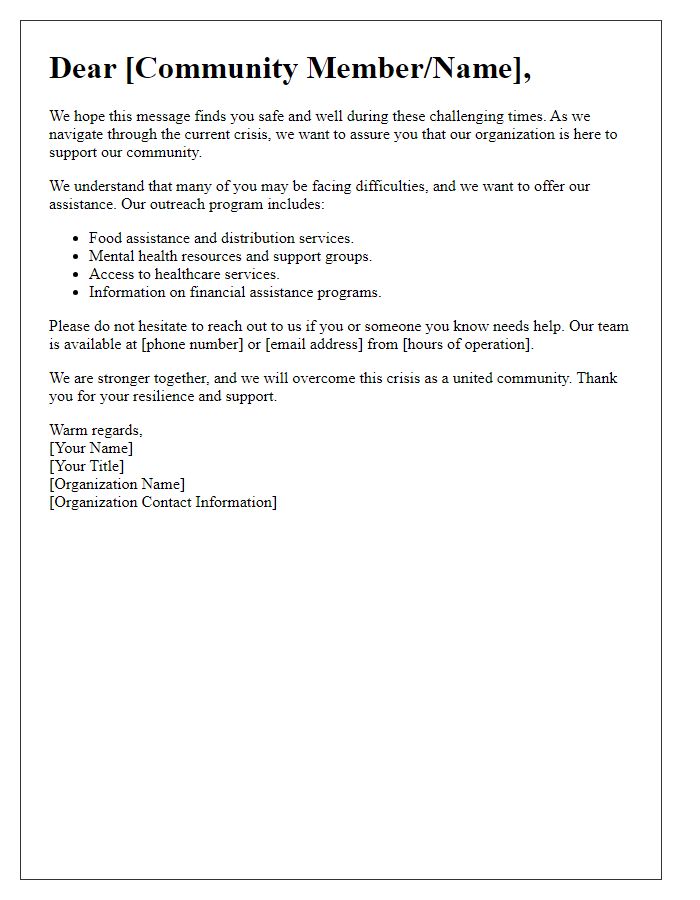In today's fast-paced world, effective communication during a crisis is more essential than ever. Whether it's a company facing unexpected challenges or an organization navigating public scrutiny, having a robust crisis communication plan can make all the difference. This letter template will guide you through crafting clear, empathetic messages that resonate with your audience and maintain trust. Join me as we explore the key elements of an impactful crisis communication strategy!

Clear subject line
A clear subject line in a crisis communication plan serves as the first impression for all recipients, immediately informing them about the essence and urgency of the message. A well-structured subject line should include the nature of the crisis, such as "Urgent: Data Breach Notification - Immediate Action Required," alongside the date and relevant department, ensuring recipients understand the significance and context of the situation. This approach aids in swift identification and prioritization among various communication channels, whether emails, text alerts, or official memos, optimizing the response and management processes during crucial moments.
Immediate response priority
In a crisis communication plan, immediate response priority is essential for maintaining public trust and ensuring safety. First, gather a crisis management team consisting of key leaders from various departments, such as Communications, Operations, and Human Resources. Second, identify the nature of the crisis, whether it's a natural disaster (such as hurricanes or floods impacting operations), data breach affecting customer privacy, or product recall due to safety issues, ensuring understanding of the severity and scope. Third, establish clear and concise messaging to disseminate to stakeholders, including employees, customers, and media outlets, providing timely updates and factual information. Utilize various channels such as social media platforms (like Twitter, Facebook) and official press releases to ensure widespread communication. Finally, monitor public response through analytics tools, adjusting the communication strategy as necessary to address concerns and mitigate misinformation, promoting transparency and accountability throughout the crisis.
Empathy and reassurance
In times of crisis, effective communication is essential to addressing concerns and providing reassurance to stakeholders. Empathy is vital in understanding feelings and frustrations of affected individuals. Clear messaging should reflect awareness of the challenges faced, such as potential disruptions or safety issues. The communication should also provide specific information about the steps being taken to resolve the situation, emphasizing the commitment to ensuring well-being. Highlight resources available for support, ensuring that stakeholders feel valued and heard during difficult times. Offering an open line of communication fosters trust and allows for the ongoing exchange of information, reinforcing the organization's dedication to transparency and accountability throughout the crisis.
Key information and facts
In a crisis communication plan, key information and facts are crucial for maintaining trust and transparency. The nature of the crisis, whether it is a public health emergency, such as the COVID-19 pandemic, or a corporate issue, like a product recall affecting thousands of consumers, dictates the messaging approach. Establishing a clear timeline of events, including critical dates and decisions made, plays a vital role in understanding the situation. Identifying stakeholders, such as employees, customers, media, and regulatory bodies, is essential to tailor communication effectively. Clear, factual statements about the impact, necessary actions taken, and future steps should be clearly outlined. Metrics to monitor the effectiveness of communication and public sentiment, such as social media engagement or customer feedback, must be tracked diligently for iterative improvement.
Contact information for further assistance
Contact information for further assistance is crucial during a crisis communication plan to ensure timely responses. Designated point of contact, such as John Smith, can be reached via email at john.smith@company.com or by phone at (555) 123-4567. The public relations team, helmed by Sarah Jones, is available for media inquiries at sarah.jones@company.com or (555) 987-6543. Additionally, a dedicated crisis hotline, 1-800-CRISIS, operates 24/7 for immediate support. All communications should be documented and logged for later review, ensuring transparency and accountability during recovery efforts.













Comments